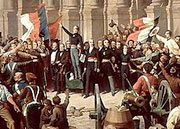
This is the second part of a two-part essay. Read the first part here.
Part II
The opposition’s forces in both 1848 European revolutions and 2011 Arab Spring were not the initiators of the uprisings, but they certainly took advantage of the opportunity to advance their political agenda. Civil society in 1848 and NGOs in 2011, however, played a seminal role in fostering a sense of common grievance against immobile regimes and helped, therefore, to spread the revolutions beyond their original borders.
In the context of the Arab uprisings, the Islamists arrived late to the protest squares out of fear that venturing beyond what is permissible might make them pay the usual price: incarceration and torture. So, they waited. When convinced that the regimes’ security apparatus is no longer capable of overcoming the tide of indignation by the young over ossification and corruption of imbecile regimes, they joined. They brought to the fray, superior organizing skill, thereby compounding the difficulties of the entrenched regimes. By doing so, they usurped, from the inexperienced youth, the leadership of the uprisings.
Many countries in the Arab Spring are in transitions; others remain in deadly stalemates with oppressive regimes. In these circumstances, it is rather early to render a judgment as to whether a turning point in Arab modern history is already unfolding or it has, as A.J.P. Taylor said about 1848: “reached a turning point and failed to turn.”
Regional and extra-regional meddling is only delaying the inevitable. Like the 1848 European revolutions, the Arab Spring is a transnational phenomenon. In such cases, the “great powers” became involved to protect their interests by trying to shape the outcome. Those who perceive their interests to be consonant with the existing status quo, because they prefer current elite to the unpredictable, are behaving in a manner that is detrimental to their long-term interests and are, therefore, prolonging the agony of the people. The forces of Czarist Russia and Habsburg, Austria collaborated to reverse the gains of 1848 European revolutions.
The historian Eric Hobsbawm reminded us that: “Two years after 1848, it looked as if it had failed. In the long run, it had not failed. A good deal of liberal advances had been made. So it was an immediate failure but a long-term political success-though no longer in the form of a revolution.” It is obvious that the spark of revolution is too resilient to be effaced.
Unlike the situation in the Arab uprisings, national emancipation was an important issue in 1848.
The Italians and the Germans struggled to unify Italy and Germany, and to rid their countries of Austrian and Prussian dominations, respectively. In that year, Hungary also rose to regain freedom from the yoke of imperial Vienna. Narrow nationalistic visions were corrosive and divisive. Proponents of different ethnicities clashed and never pondered over the fairness of the other side’s claims; nor apparently was compromise seriously considered. This provided the counter-revolutionaries and their foreign backers with the opportunity to realize their nefarious goals of setting back the clock.
Responding fairly to the legitimate concerns of ethnic and religious minorities would probably have ensured the success of the 1848 European revolutions. This is the most important lesson for today’s Arab revolutionaries.
Obviously, the geographic atmosphere of 1848 Europe was not favorable to a revolution. Nor is, for that matter, the 2011 Arab geographic space more accommodating. The French attempt in 1848 to export revolutions in order to erase French humiliation at the Congress of Vienna of 1815, was damaging to prospect success of the European revolutions. Arabs must avoid provoking other regimes in the region by threatening to export revolutions. So far they are doing exactly that.
Abdullah Alsaidi is a Senior Fellow at the International Peace Institute, and was the Permanent Representative of Yemen to the United Nations from 2002 until his resignation in March 2011.
About the photo: A detail of a painting by Henri Félix Emmanuel Philippoteaux, “Lamartine, before the Hôtel de Ville, Paris, rejects the Red Flag.”




